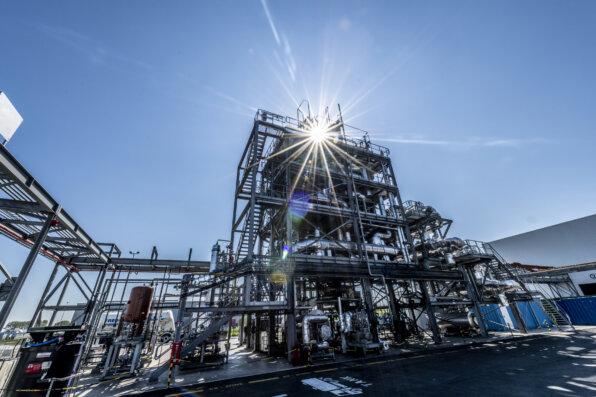Our View on Climate and Energy
Climate change is arguably the biggest threat to our civilization. Producing energy from fossil fuels has enabled unprecedented progress for humanity, but burning coal, oil and natural gas has increased the concentration of greenhouse gases (GHGs) such as carbon dioxide in the atmosphere. The clearing of land for agriculture, industry, urbanization and other activities has also contributed to that increase, although to a lesser extent.

Background
The consequences are difficult to predict precisely but certain effects of climate change are certain. For example, the Earth is becoming warmer, weather events such as heatwaves are becoming more severe, the sea levels are increasing, as ice on land melts and seawater expands as it warms, and the productivity of agriculture is changing, all provoking human migration. Taken as a whole, the evidence indicates that the net costs of climate change are significant and that they will further increase over time.
The COP21 Paris Agreement calls on all countries to keep the global temperature increase to well below 2°C above pre-industrial levels and to pursue efforts to limit the increase to 1.5°C. In this context, the European Union is committed to being the first carbon-neutral economy by 2050 and will therefore define its long-term GHG emission reduction strategy. This strategy is expected to fundamentally transform all sectors of the European economy, creating business risks and opportunities.
The EU has already put a price on carbon emissions through the EU-ETS cap and trade mechanism, which monitors overall emissions and aims to reduce them. The newly established EU Carbon Border Adjustment Mechanism (CBAM) will put a price on the carbon emitted during the production of carbon intensive goods that are entering the EU and will support the decarbonization of EU industry. Through the Green Deal the EU will further push policies to increase the scope and incentives to reduce emissions. Other economic powerhouses will follow at some stage. As one of the largest and most-diversified industries in Europe, and as an important emitter of GHGs, the chemical industry plays an important role in helping achieve a just transition to lower long-term GHG emissions, thanks to its innovative solutions, while increasing Europe’s competitiveness both locally and globally.
Our View
Our Products Are Part of the Solution
Our products can contribute to the fight against climate change. Polyolefins’ (PO) key advantage against alternative materials is their lightness and durability, which makes them ideal for applications such as vehicles and packaging. All car manufacturers use plastic composites that meet durability requirements but can weigh 10-50% less than alternative materials, helping to reduce fuel use and CO2 emissions. PO is also an essential component of electric vehicles.
PO also helps to reduce GHG emissions in other ways. For example, plastic packaging avoids food wastage by increasing shelf life. If food wastage were a country, it would be the third-largest GHG emitter in the world.
In addition, the need to continuously improve energy and resource efficiency in all sectors of the economy will drive growth and innovation in the PO industry. For example, PO is a key enabler of renewable energy, as a component in photovoltaic panels and as an insulator for cables carrying renewable energy.
Policy makers and governments need to put in place measures to incentivize the transition to products and solutions that fight climate change and protect them from unfair competition.
The Circular Economy Is the Lever for Reaching a Climate-Neutral Society
Using more recycled plastics and renewable feedstock is a way to decouple carbon emissions from both PO production and the incineration of PO waste, thereby seamlessly linking the energy and littering challenges the PO industry faces.
We are committed to the Circular Economy, including investing in our recycling operations, fostering collaboration in our value chain and exploring new opportunities that reduce climate change. See Our View on the Circular Economy for more on this topic.
We Are Committed to Significantly Reducing the Impact of Plastics Production
In the chemical sector, moving towards carbon neutrality requires a number of significant changes. The industry will need to transform its existing plants and invest in new industrial pathways and processes. It will also need to make circular use of alternative feedstocks, such as bio-feedstocks or recycled sources, and use CO2 as a source for important single-carbon compounds such as methanol. Sectoral integration, in which energy consuming sectors such as the chemical industry are closely coupled to the power-producing sector through smart infrastructure, will also play an important role.
At Borealis, energy and climate is one of the three core elements of our sustainability strategy. We are committed to reducing the CO2 emissions from our production, by improving our energy and process efficiency. The defined energy ambition is to implement 10% energy savings of the consumption of 2015 by 2030.
We are also increasing the share of renewable energy we use. Our aspiration is for renewables to supply 100% of the electricity consumed by our European asset base by 2030.
In addition, we aim to reduce the CO2 emissions in the supply chain of our feedstock and products, alongside our logistics service providers and partners. For example, we have introduced trucks fueled by liquefied natural gas (LNG) for regular deliveries to customers. These trucks have 25% lower CO2 emissions than comparable diesel-powered trucks. The charter vessel we use to source some ethane has also been converted to run on LNG.
A more detailed description of our GHG emission reduction targets can be found in our Sustainability Strategy.
To increase transparency about our environmental performance, we are committed to improving the information we disclose, in line with the latest climate-related reporting standards.


